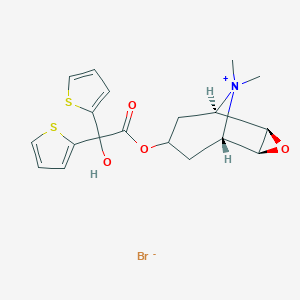Asthma, Chronic obstructive pulmonary disease
Adult: As inhalation cap: 1 cap (18 mcg) daily via inhaler device, at the same time each day. As inhalation soln: 2 inhalations (5 mcg) daily, at the same time each day.
|
Indications and Dosage
Inhalation/Respiratory
Asthma, Chronic obstructive pulmonary disease Adult: As inhalation cap: 1 cap (18 mcg) daily via inhaler device, at the same time each day. As inhalation soln: 2 inhalations (5 mcg) daily, at the same time each day.
|
||||
|
Renal Impairment
|
||||
|
Contraindications
Hypersensitivity to tiotropium bromide, atropine or its derivatives.
|
||||
|
Special Precautions
Patient w/ narrow-angle glaucoma, prostatic hyperplasia/bladder neck obstruction, cystic fibrosis. History of MI (<6 mth), or unstable or life threatening cardiac arrhythmia w/in the past yr. Not intended for use as initial treatment for acute bronchospasm and as monotherapy for asthma. Moderate to severe renal impairment (CrCl ≤50 mL/min). Pregnancy and lactation.
|
||||
|
Adverse Reactions
Dry mouth, upper resp tract infection, pharyngitis, sinusitis, rhinitis, epistaxis, non-specific chest pain, UTI, dyspepsia, hypersensitivity reactions (e.g. urticaria, angioedema, rash, itching), dizziness, dysphagia, hoarseness, intestinal obstruction, increased intraocular pressure, palpitations, tachycardia; application site irritation (e.g. glossitis, mouth ulceration, pharyngolaryngeal pain).
Potentially Fatal: Paradoxical bronchospasm, anaphylaxis. |
||||
|
Patient Counseling Information
This drug may cause dizziness and blurred vision, if affected, do not drive or operate machinery.
|
||||
|
Monitoring Parameters
Monitor pulmonary function.
|
||||
|
Drug Interactions
Additive effect w/ other anticholinergic drugs.
|
||||
|
Action
Description:
Mechanism of Action: Tiotropium bromide antagonises the cholinergic effects of acetylcholine by reversibly and competitively binding to type 3 muscarinic (M3) receptors, resulting in bronchial smooth muscle relaxation. Pharmacokinetics: Absorption: Systemically absorbed from the lungs. Bioavailability: Approx 20% (dry powd inhalation); approx 33% (inhalation soln). Time to peak plasma concentration: 5 min (dry powd inhalation); 5-7 min (inhalation soln). Distribution: Volume of distribution: 32 L/kg. Plasma protein binding: Approx 72%. Metabolism: Undergoes minimal hepatic metabolism by non-enzymatic cleavage and by CYP2D6 and CYP3A4 isoenzymes. Excretion: Via urine as unchanged drug. Half-life: 5-6 days (dry powd inhalation). |
||||
|
Chemical Structure
 Source: National Center for Biotechnology Information. PubChem Database. Tiotropium bromide, CID=5487426, https://pubchem.ncbi.nlm.nih.gov/compound/Tiotropium-bromide (accessed on Jan. 23, 2020) |
||||
|
Storage
Inhalation cap: Store at 25°C. Protect from excessive heat and moisture. Do not store in inhaler device. Inhalation soln: Store at 25°C. Do not freeze.
|
||||
|
MIMS Class
|
||||
|
ATC Classification
R03BB04 - tiotropium bromide ; Belongs to the class of other inhalants used in the treatment of obstructive airway diseases, anticholinergics.
|
||||
|
References
Anon. Tiotropium. Lexicomp Online. Hudson, Ohio. Wolters Kluwer Clinical Drug Information, Inc. https://online.lexi.com. Accessed 08/07/2015. Buckingham R (ed). Tiotropium Bromide. Martindale: The Complete Drug Reference [online]. London. Pharmaceutical Press. https://www.medicinescomplete.com. Accessed 08/07/2015. Spiriva Capsule (Boehringer Ingelheim Pharmaceuticals Inc.). DailyMed. Source: U.S. National Library of Medicine. https://dailymed.nlm.nih.gov/dailymed/. Accessed 08/07/2015.
|